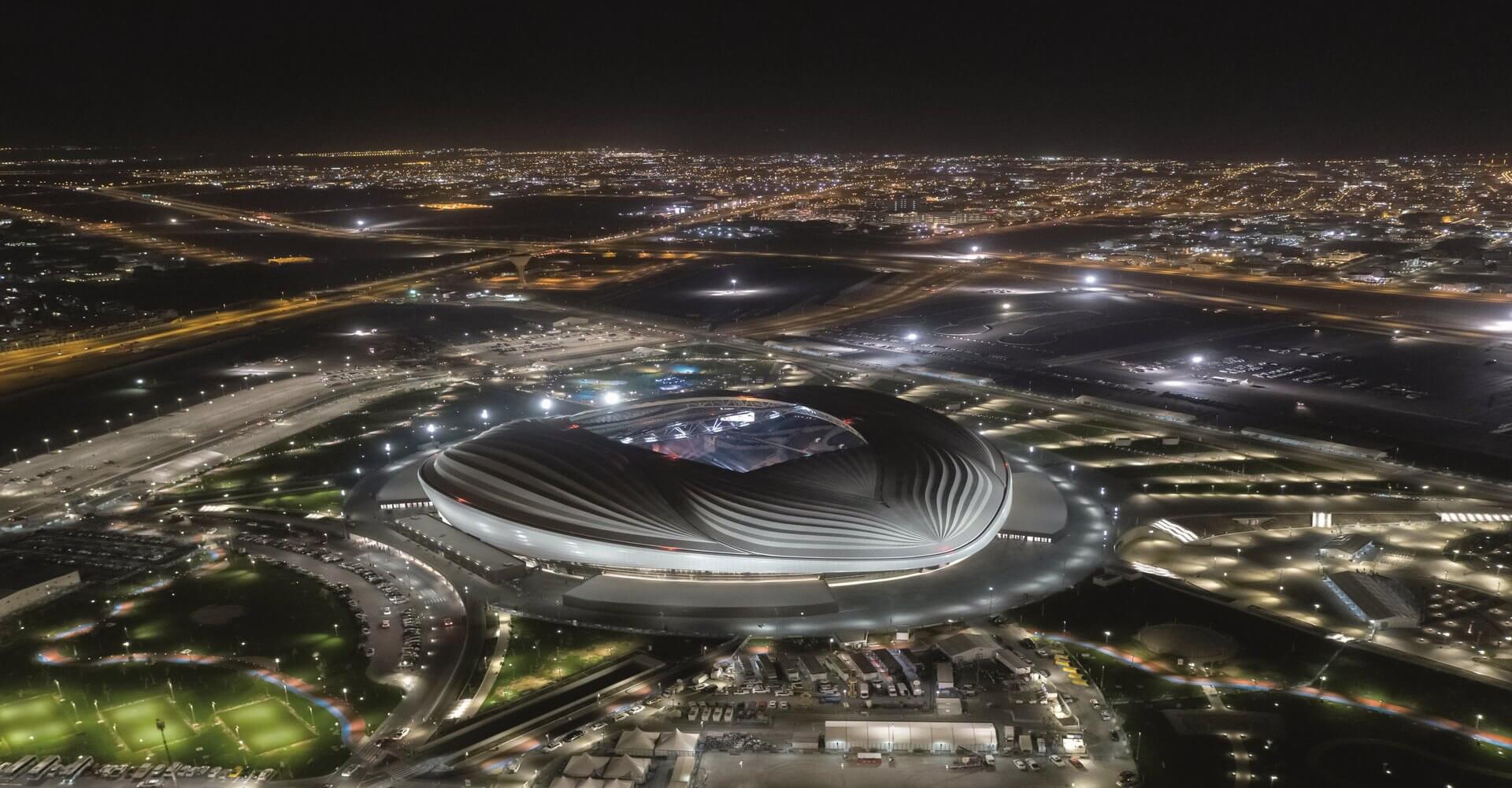沃克拉市的贾努布体育场是2022年卡塔尔世界杯的第二个比赛场地,由传奇建筑师扎哈·哈迪德设计。这位伊拉克裔英国设计大师于2016年去世,沃克拉市的贾努布体育场是她最后的项目之一。
扎哈·哈迪德建筑事务所总监吉姆·海芙琳针对沃克拉贾努布体育场的原始设计概念进行了大量工作,最近他首次参观了完工的场馆。
本文中他讨论了设计的灵感,并想象如果扎哈·哈迪德能看到完工的体育场,她会有什么样的反应。
问:您对建成的体育场的第一感觉是什么?
答:见到场馆如此精准地复现了我们当初的设计概念时,我非常惊讶。通常,当你有段时间没到施工现场,肯定还是会在看到实体前不免忐忑。我要将本次建造成果的一致性归功于建造团队。场馆建成后看起来很震撼——我还到处转了转,留意到了一些早期阶段构想的设计元素。室内和室外看起来都很棒。
在这个设计中,我们试图实现一些独特而又精美的方案——但同时也不会缺失功能性。我认为这个项目达到了这些目标,能成为这个项目的一员真是一件值得骄傲的事。
问:是什么激发了你们构想出这样的设计?
答:我们团队通常会挑战做一些独特的事情。尤其像体育场这种建筑类型,它们受到法规的约束,似乎开始变得有点通用和重复。但我们想努力回应客户的任务书,想做一些与沃克拉市产生共鸣的事情,所以我们从单桅帆船这个意象开始。我们不想单纯复制一艘单桅帆船的样态,我们将其抽象化,以创造出动态和有机感——使它能承载多重理解。
场馆在功能上是全面的,但在外观上却不是全圆的。它从沃克拉市不同的角度看会是不同的形态——这是我们试图实现的目标。我觉得这个设计很吸引人——人们会喜欢并认同它。这个项目具有非常亲民的一面,建造的初衷是让其代表沃克拉市,成为市容形象的一部分。如果人们喜欢这座场馆就会慕名而来,它也就会被长期使用——不仅是在比赛日,平时也可以是出行的目的地。
问:你们认为新建筑融入自然景观有多重要?
答:新建筑当然不可能是完全隐形的,那样的话需要付出很大的努力,而且不是正确的策略。它需要成为人们的参考方位和可认可的地标,成为城市公民活动的一部分。我认为沃克拉市能以它为轴心发展,这会相互更加成功,因为在它周边就会辐射出相关联的城市公共要素,形成一系列协同功能,从而与不断发展的沃克拉市紧密互动起来。
问:扎哈·哈迪德会如何看待这座完工的体育场?能参与到该地区第一次承办世界杯这样的活动之中,她会为此而自豪吗?
答:扎哈她会喜欢的。虽然她并不怎么喜欢运动,但她喜欢这种场面,她喜欢这种魅力,在文化上她向往自己所属的文化地域能举办如此盛大的活动,也期望自己能献上一份力。当我们在2012年伦敦奥运会上(设计水上运动中心),扎哈就很激动地买了张门票,默默作为观众享受其中的体验。我相信她也愿意在这座场馆里这么做。每当看到一座建筑完工时,扎哈总是非常兴奋,因为在她早期职业生涯中,很多委托项目夭折让她备受痛苦。这里和她的家乡——以及她从未失去亲近感的地区和文化——非常贴近,对她来说这真的很重要。
问:如果她现在在这里,你觉得她会说什么?
答:她可能一开始会抱怨!但最终她会非常地高兴。她会惊讶于项目的完成度和我们所要实现的最初目标是那么接近,执行度是那么高,那些美丽的褶皱和美丽的线条,以及细节的关注和刻画。当你看到设计成为现实时,它是非常令人兴奋的。一般来说,如果她先提出一些批评意见,然后止不住地赞扬和表达自己多么喜欢,我们就知道她是有多兴奋了。(张萃 译)
本文稿图片和数据均由扎哈·哈迪德事务所提供。
Al Wakrah Stadium – the second tournament-ready venue for the FIFA World Cup Qatar 2022™ – was designed by the legendary architect Zaha Hadid. The Iraqi-British icon passed away in 2016, meaning Al Wakrah Stadium was one of her final projects.
Jim Heverin, Director, Zaha Hadid Architects, worked extensively on the original design concept for Al Wakrah Stadium and recently visited the completed venue for the first time.
Here he discusses the inspiration for the design and speculates on how Hadid would have reacted to seeing the finished stadium.
Q: What are your initial thoughts on the completed stadium?
A: I'm amazed at how literal it is to the concept we drew. You're always a little scared when you haven't seen something for a while but I can only give credit to those who have delivered it because it really looks like our original concept. It looks amazing – I've walked all around and it's really enjoyable to see things that you thought about in the early stages. It's looking fantastic inside and out.
With the design, we were trying to achieve something that's unique and beautiful – but also something that's very functional. I think we've achieved all those things and to be part of that is something to be proud of.
Q: What inspired you to come up with a design like this?
A: We always challenge ourselves to do something unique. Football stadiums, in particular, are dictated by regulation these days which means they have become a little bit generic and repetitive. We wanted to respond to the client's brief, which was to do something which resonated with Al Wakrah, so we started by looking at the dhow. We didn't want to literally blow up a dhow boat so we looked at abstracting it in order to create something dynamic and organic – something that has multiple interpretations.
The stadium is quite circular in terms of its functionality but it's not circular in terms of its appearance. It has different views from different parts of Al Wakrah – which is something we tried to achieve. I feel the design is engaging – to the point where people will like it and want to be associated with it. This project has a very civic aspect to it and the aim is for the stadium to represent Al Wakrah and become part of the iconography of what Al Wakrah is. If the stadium is adopted and well-loved, then it will be used – people will come here, not only on match days, and it will become a destination.
Q: How important is it for new buildings to blend in to the natural landscape?
A: Well they can't be invisible as that would take such an effort and wouldn't be the right approach. It needs to be something that people orientate towards and recognise, something that becomes part of the civic fabric of the city. I think Al Wakrah will come to grow around it and that will only make it more successful because then you have a whole series of synergies in terms of other types of uses beside it which start to tie in with the growing city that is Al Wakrah.
Q: What would Zaha Hadid make of the finished stadium and how proud was she of being a part of the first FIFA World Cup™ in this region?
A: Zaha would have loved it. She wasn't really into sport but she loved the spectacle, she loved the glamour and culturally she loved the fact that her part of the world was going to host such a massive event and be part of it. When we participated in London 2012 [by designing the Aquatics Centre], Zaha was really keen to get tickets and enjoy the experience as a spectator, and she would have been the same for football. Zaha was always super excited whenever she went to see a building completed because she had a lot of pain in her early career with failed commissions. This being very close to her homeland – and an area and culture she never lost an affinity and closeness to – would have been really important to her.
Q: What do you think she would have said if she was here now?
A: She would have complained at first! But in the end she would be very, very happy. She would have been amazed at how true it is to what we set out to achieve, how well executed it is, with the beautiful folds and beautiful lines, and all the care and attention. When you see a design as reality it is very exciting and we would have been able to judge her excitement by the fact there would have been a few criticisms before she moved on and said how much she liked it.



